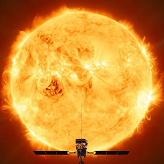Launch of the Solar Orbiter satellite

 The Solar Orbiter satellite, before its integration into the Atlas V rocket. Credit: ESA
The Solar Orbiter satellite, before its integration into the Atlas V rocket. Credit: ESA
The European Space Agency's Solar Orbiter mission took off the night of February 9 to 10 from Cape Canaveral. Like her American sister Parker Solar Probe, she will get closer to the Sun at such a short distance that she must take on board a specific instrumentation developed by the Laboratory of Plasma Physics (LPP) *.
A technological accomplishment
The Solar Orbiter satellite will position itself at a distance of 30 solar diameter in order to combine observation of the sun and analysis of the solar wind. Protected by a heat shield, it will nevertheless undergo an energy flow 20 times greater than that of the satellites of our planet and therefore required suitable instruments. A technological feat for which the LPP has provided a miniaturized system for detecting electrons in the solar wind and an electromagnetic wave analyzer capable of reducing the amount of data transmitted to Earth while optimizing their scientific value. These instruments were designed with the help of the National Center for Space Studies (CNES).
Better understand the magnetic field
The mission has many challenges: it involves understanding the origin and the dynamics of the solar wind that fills the interplanetary space and elucidating the mechanisms of generation of the solar magnetic field. This magnetic field is the source of the 11-year solar cycle and has a complex structure on the surface of the Sun. It suddenly reconfigures during solar flares which can send energetic particles, ionizing radiation, and clouds of magnetized plasma throughout the heliosphere. These events affect planetary environments: they can damage satellites in Earth orbit and affect our means of communication and positioning by GPS. The Solar Orbiter mission will provide a better understanding of the origin and propagation in the heliosphere of these major disturbances in the space environment.
An ESA - NASA duo
Through its trajectory, the European Solar Orbiter mission will also provide new images of the Sun's poles. It will work in conjunction with the American Parker Solar Probe launched in August 2018. Parker Solar Probe, which embeds the LPP's electron detection system, will move toward the Sun at a minimum distance of 4.5 solar diameters, but cannot observe it directly. Using its telescopes, Solar Orbiter will provide the context for the space environment in which the American probe is operating. Solar Orbiter and Parker Solar Probe open a golden age for the study of the Sun and heliosphere plasmas.
> Find out more: ESA website
> Read also: The LPP involved in the Parker Solar Probe mission
* A joint research unit : CNRS / École Polytechnique / Observatoire de Paris / Université Paris-Saclay / Sorbonne University
 Support l'X
Support l'X